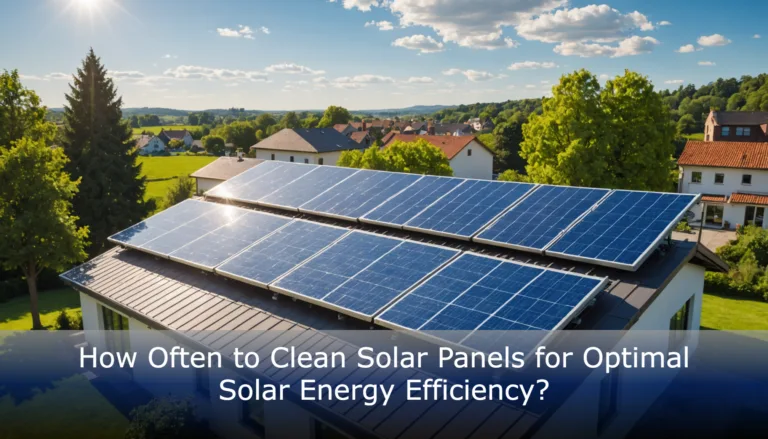How Much is the Tax Credit for Solar Panels? The 2025 Federal Solar Tax Credit for Homeowners
Are you curious about how much money you can save when installing solar panels? Knowing how much is the tax credit for solar panels can put you in the driver’s seat to make eco-friendly choices while saving cash! This tax credit isn’t just a number; it’s a golden opportunity for homeowners looking to lower their electricity bills and lessen their impact on the planet.
Understanding this tax credit is super important because it can reduce the initial costs of your solar energy system significantly. If you don’t get the details right, you might miss out on thousands of dollars in savings! In this article, we’ll explore the current amount of the federal solar tax credit, what changes are coming by 2025, and how you can qualify. Get ready to dive into the exciting world of solar energy and discover how to make the most of these amazing incentives!
Understanding the Federal Solar Tax Credit

What is the Federal Solar Tax Credit for Homeowners?
The federal solar tax credit, also called the Residential Clean Energy Credit, gives homeowners a financial benefit for installing solar energy systems. Homeowners can deduct 30% of the installation cost of solar panels from their federal taxes for systems installed between 2022 and 2032. After 2032, this credit will drop to 26% in 2033 and 22% in 2034. This incentive encourages the use of solar energy, making it easier for homeowners to adopt this renewable resource while reducing their financial burden.
How Are Tax Credits Calculated?
Calculating tax credits for solar panels is simple. The tax credit is based on the total cost of the solar energy system. For instance, if a homeowner installs a solar system costing $20,000, they can claim a tax credit of $6,000. This is 30% of $20,000. Therefore, a higher installation cost means a larger tax credit, allowing homeowners to save significantly on their federal taxes.
Key Terms to Know: Credit for Solar, Rebates, and Incentives
Understanding key terms related to solar tax credits can help homeowners make informed decisions. Here are some important definitions:
- Tax Credit: A dollar-for-dollar reduction in tax owed. For example, if a homeowner owes $10,000 in taxes and claims a $6,000 tax credit, they only pay $4,000.
- Refundable Credit: This credit allows homeowners to receive a refund if the credit amount exceeds their tax liability. For example, if a homeowner qualifies for a $6,000 tax credit but only owes $4,000, they would receive a refund of $2,000.
- Non-refundable Credit: In this case, if the credit exceeds the tax owed, the taxpayer does not receive a refund for the difference. For example, if a taxpayer qualifies for a $6,000 tax credit but only owes $4,000, they lose the remaining $2,000.
This knowledge of tax credits, rebates, and incentives empowers homeowners to maximize the benefits when investing in solar energy systems. (IRS Residential Energy Credits)
How Much Is the Tax Credit for Solar Panels?

Current Amount of the Federal Solar Tax Credit
The federal solar tax credit, also called the Residential Clean Energy Credit, is currently set at 30%. This means homeowners can deduct 30% of the total cost of installing solar panels from their federal income taxes. To qualify, the installation must be completed by the end of 2032. This credit covers all installation costs, including equipment, labor, and other eligible expenses, providing significant financial relief for homeowners investing in solar energy systems. [IRS]
Changes to Solar Tax Credits By 2025
The solar tax credit will stay at 30% until it begins to decrease after 2032. Homeowners should note that delaying their solar system installation may result in a smaller credit in future years. Taking advantage of this incentive now can lead to substantial savings when switching to solar energy. [Energy.gov]
Understanding Credit Qualification for Solar Panels
To qualify for the federal solar tax credit, homeowners need to meet specific requirements:
- The solar energy system must be installed on a primary or secondary residential property.
- The homeowner must own the solar energy system outright; leasing it does not qualify for the tax credit.
- Importantly, there are no income limits for this credit, making it available to many homeowners.
Understanding the current tax credit and its requirements is essential for homeowners considering solar energy systems. Awareness of the 30% credit and its future changes helps homeowners maximize their financial benefits when investing in renewable energy solutions.
Solar Installation: Costs and Benefits for Homeowners

Breakdown of Costs Associated with Residential Solar
The cost of installing solar panels can vary significantly. Typically, homeowners can expect to pay between $15,000 and $30,000 for a solar energy system. Several factors influence the total cost, including the system size, the home’s location, and specific installation details.
Key Cost Components:
- Solar Panels: The main part of the system. Prices vary based on brand and efficiency.
- Inverter: This device converts solar energy into usable electricity for the home.
- Installation Costs: Labor costs for professional installation can add to the total price.
- Permitting and Inspection Fees: Local governments often require permits, which can increase overall expenses.
- Additional Equipment: Battery storage and other extras can enhance the system but will increase the total cost.
Homeowners can benefit from the federal solar tax credit, which allows them to deduct 30% of installation costs from their federal income taxes. This credit makes solar energy more affordable and encourages investment in renewable sources.
Long-term Savings from Using Solar Energy
Investing in solar energy can lead to significant long-term savings. Many homeowners report saving $1,000 or more annually on their electricity bills. The actual savings depend on local energy prices and the solar system’s size.
Factors Influencing Savings:
- Energy Rates: Higher local utility rates lead to greater savings from solar energy.
- System Size: Larger systems produce more energy, resulting in higher savings.
- Net Metering: Some states allow homeowners to sell excess energy back to the grid, boosting savings.
These savings help homeowners recoup their initial investment over time. Calculating potential savings based on local energy costs and expected solar production is crucial to understanding the financial benefits.
How Solar Incentives Can Affect Your Investment
Federal tax credits, state incentives, and local rebates can significantly lower the upfront costs of solar installations.
Key Incentives Include:
- Federal Solar Tax Credit: Deductions of up to 30% on installation costs.
- State-Specific Incentives: Some states provide additional tax credits or rebates to promote solar energy.
- Utility Rebates: Local utility companies may offer financial incentives for homeowners who install solar systems.
By utilizing these incentives, homeowners can enhance their return on investment (ROI). The more incentives claimed, the lower the total costs, making solar energy a more appealing option.
Exploring Energy Tax Benefits for Eligible Homeowners

Federal Taxes and Solar Energy Installations
The federal solar tax credit, known as the Residential Clean Energy Credit, allows homeowners to deduct 30% of the cost of installing solar panels from their federal income taxes. This tax credit is valid for systems installed between 2022 and 2032. It is a non-refundable credit, meaning it can reduce tax liability to zero but won’t provide a cash refund if the credit exceeds the tax owed.
To claim the credit, homeowners must report their solar energy system on their federal tax return using IRS Form 5695. This form helps calculate the credit. Many find this tax credit essential for making solar installations more affordable, encouraging the growth of renewable energy.
Additional Solar Incentives and Grants Available
Homeowners can access various state-specific incentives, rebates, and grants in addition to the federal solar tax credit. These incentives can greatly reduce the costs of installing solar energy systems. For example, many states offer tax credits that, when combined with the federal credit, lead to substantial savings.
- Rebates: Utility companies may provide rebates for installing solar panels, lowering the upfront costs.
- Grants: State or local government programs may offer grants to promote renewable energy adoption. Homeowners should check eligibility for these programs.
Combining these incentives with the federal tax credit can help homeowners recover a significant portion of their solar installation expenses.
State-Specific Tax Credits for Residential Solar
Many states have unique solar incentives that vary widely. For example, New York offers state tax credits that, when combined with the federal solar tax credit, can cover about 50% of the total installation cost. Other states may have different programs to help homeowners offset installation costs.
- Example: In California, homeowners benefit from the California Solar Initiative, which provides rebates for solar installations, making solar energy more accessible.
- Eligibility: Homeowners must ensure their solar energy system meets specific efficiency criteria to qualify for state credits. Each state has different requirements, so it is important to research the details in the respective state.
By leveraging both federal and state incentives, homeowners can significantly lessen their financial burden when choosing solar energy systems.
References
- Palmetto – Federal Solar Tax Credit
- Yahoo Lifestyle – Homeowner Savings
- Kasselman Solar – New York Solar Incentives
Current Trends and Future Developments in Solar Incentives

Research on Solar Tax Credit Effectiveness
The federal solar tax credit, also called the Residential Clean Energy Credit, helps homeowners afford solar energy systems. Research indicates that this tax credit has significantly increased the number of homeowners choosing to install solar panels. By allowing homeowners to deduct 30% of their installation costs from federal taxes, the credit reduces the upfront expense, making solar energy a more attractive choice for families.
Moreover, the solar industry has grown due to the tax credit’s success. Many homeowners find that this financial incentive eases the initial costs, which can be a barrier to going solar. The Solar Energy Industries Association (SEIA) reports that the tax credit has led to a strong rise in solar installations nationwide, creating thousands of jobs and promoting clean energy use. The ongoing demand for solar technology suggests that the tax credit will continue to motivate homeowners to invest in solar energy systems.
Expected Changes in Solar Tax Policies Post-2025
Looking forward, the solar tax credit is expected to remain at 30% until the end of 2032. However, discussions about future changes to solar tax policies are already underway. After 2032, the tax credit is projected to decrease, potentially dropping to 26% in 2033 and 22% in 2034. If no new laws are passed, the credit may expire entirely in 2035.
These discussions emphasize the importance of renewable energy and how policies might evolve to support long-term sustainability goals. As the government aims to cut carbon emissions, any changes to solar incentives may reflect broader environmental policies. Homeowners should consider acting soon to benefit from the current incentives, as advocates for renewable energy hope that ongoing support for clean energy will lead to the renewal or expansion of tax credits, further fostering growth in the solar industry.
References:
- NerdWallet: Solar Tax Credit Overview
- Cedar Creek Energy: 2025 Federal Solar Tax Credit Guide
- Palmetto: Everything You Should Know About the Solar Tax Credit
Conclusion
In summary, the federal solar tax credit is a valuable incentive for homeowners looking to install solar panels. It can significantly reduce the cost of your solar energy system, making it more affordable. Understanding how these credits are calculated and the benefits they offer can help you make informed decisions about your energy future. Additionally, knowing about changes coming by 2025 can prepare you for the best possible savings.
As you explore the possibilities of going solar, remember that there are many ways to benefit from these incentives. Keep learning about how to claim the tax credit and the long-term savings available. The journey toward renewable energy can be exciting, and every step you take brings you closer to energy independence!
FAQs
1. How does the federal solar tax credit work?
The Federal Solar Tax Credit helps homeowners save on federal taxes when they install a solar energy system. Homeowners can claim this credit on their federal income tax return for the year they install the solar system. This credit directly reduces the amount of tax owed. For example, if a homeowner spends $20,000 on a solar system, they can claim a credit of $6,000, which is 30% of the total cost. This means they lower their tax bill by that amount, which may lead to a larger tax refund or reduced taxes owed.
2. Can I claim the credit for solar panels installed in previous years?
Yes, homeowners can claim the federal solar tax credit for solar panels installed in previous years if they have not already claimed it. If a homeowner installed solar panels in the previous tax year and did not take the credit, they can still claim it on their tax return. This is beneficial for homeowners who may have delayed claiming the credit or overlooked installations.
3. Are there other financial benefits to installing solar panels?
Yes, there are several financial benefits beyond the federal tax credit. Homeowners may receive state-specific tax credits and rebates, which can significantly lower the overall installation cost. Additionally, solar panels can increase a home’s property value. Research shows that homes with solar energy systems often sell for more than similar homes without them. Homeowners can also save on electricity bills because solar energy can offset the costs of buying electricity from the grid. By using solar energy, homeowners achieve long-term savings and contribute to a more sustainable environment.







